|
Edited
by Frank R. Shaw, FSA Scot, Dawsonville, GA, USA, Email:
jurascot@earthlink.net
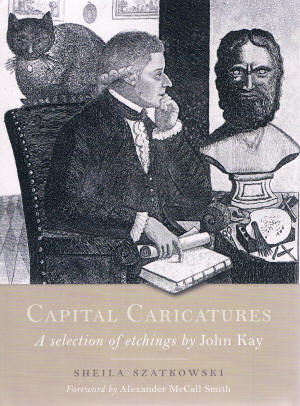
Book cover is a self
portrait by John Kay "sitting in a thoughtful posture in an antiquated
chair"
among some of his favorite things.
Several years ago while visiting the Thomas Cooper Library at the University
of South Carolina, I was going through two huge volumes entitled A Series
of ORIGINAL PORTRAITS And CHARACTER ETCHINGS by John Kay which
were published posthumously in 1837 and 1838 respectively. At the head of
the list of subscribers is HER MOST GRACIOUS MAJESTY THE QUEEN followed by
15 pages of others who thought the two volumes were worthy of subscription.
Thanks to the excellent library staff at USC, and Dr. Patrick Scott in
particular, I have sought out many rare books and articles at the library,
but I do not recall the thrill of seeing another Scottish book that excited
me like these two books.
As
fate dictates, sometime later I received notice that Birlinn Limited would
be publishing the two volumes. My, how I wanted a set but their price was a
wee expensive. However, as I read the material advertising the volumes, I
found there was an offer to members of the Society of Antiquaries of
Scotland (members are designated FSA Scot), thus making it a good buy. I
have never regretted the purchase.
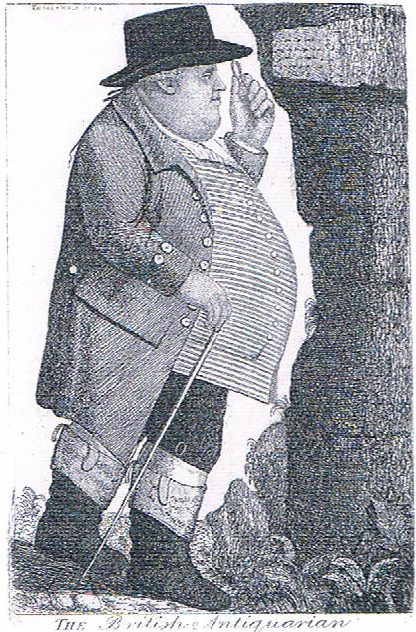
Sketch by John Kay of
Captain Francis Grose for whom Robert Burns wrote his famous Tam
O'Shanter.
Then out of the blue, I read an essay in FICKLE MAN by Sheila Szatkowski
entitled The Paparazzo, The Publisher, and The Poet. It was about
John Kay, a mixture of town barber, engraver, artist, caricaturist, and
miniature painter. John Kay produced nearly a thousand characters but
unfortunately only 400 have turned up. How could I not help falling in love
with this wonderful man? He has become a favorite Edinburgh character of
mine, thanks mostly to the work of Szatkowski in FICKLE MAN and CAPITAL
CARICATURES. Many of the Edinburgh characters we have all come to know and
appreciate over the years are in her book on Kay. Now we know what some of
them look like.
After contacting Sheila, I ordered a copy of her book which proved to be a
real treat. This marvelous book consists of one hundred of her favorite Kay
characters. In addition, the biographical notes provided by James Paterson,
an experienced journalist, and Hugh Paton, a respectable printer, show Kay’s
humor, wit, satire and comical side. You may not wish to put as much money
into the big two-volume set mentioned above, but you cannot go wrong buying
her book. It is available on Amazon.com for a modest price. As I have said
from time to time in this space, do yourself a favor and purchase one. You
will be glad you did.

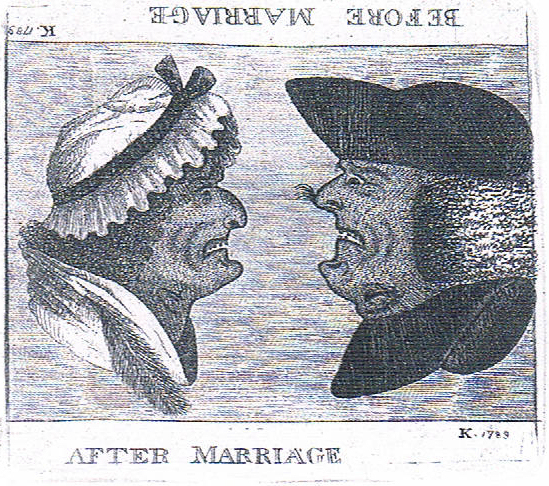
A Topsy-Turvy Affair
sketch of marriage before and after.
There is a different view if the sketch is rotated 180 degrees.
Before we go any farther, let’s consider a few details about John Kay. At
age six he was farmed out to a relative on his mother’s family and he lived
a very hard life, nearly drowning a time or two. Early in his life he “gave
strong proofs of an uncommon genius for drawing, by sketching men, horses,
cattle, houses, etc, with chalk, charcoal, or pieces of burnt wood, for want
of pencils and crayons.” Through no choice of his own he became a barber
apprentice around age 13. Six years later he moved up the road from Leith to
Edinburgh and bounced around with different masters until he was able to
secure a membership in the Society of Surgeon-Barbers in late 1771.

Alexander McCall Smith wrote the excellent
Foreword for this book
A
major turning point in his life came when Kay met William Nesbit of Dirleton
who encouraged him to excel in his drawings. Kay was able to spend a lot of
time with Nesbit which afforded him the opportunity to pursue his dream.
Nesbit became the patron of Kay and upon the death of Nesbit, Kay received
£20 annually for life. In 1785 Kay decided to leave barbering to others, and
by 1795 he had given his full attention to drawing, engraving, etc. For
nearly 50 years, few people of any reputation, famous or infamous, escaped
his attention. Thus, he was able to establish a unique sets of drawings, the
like of which no other city that I am aware of, can boast. Kay would display
his productions in the windows of his print shop, attracting the attention
of Edinburgh’s citizens. Some who had been caught by his pen even bought the
drawings to keep from public eye. In his own way, Kay was perhaps one of the
first paparazzo!
Ironically, there is not a character sketch of Robert Burns by Kay to be
found, and I cannot help but wonder if Burns is one of the missing 600. You
do the math. Being the talk of the town and being welcomed into the homes
and clubs on his trips to Edinburgh, plus the fact that Kay was quick to
capitalize on sketching visiting celebrities, Burns’s absence is otherwise
hard to understand when so many of his acquaintances in Edinburgh are in the
John Kay books. Even though there is no proof Kay sketched Burns while
visiting Auld Reekie, Kay did sketch exceptional visitors and Burns would
fit that description. One such celebrity Kay sketched was “the fashionable
balloonist” Vincent Lunardi, he of the popular “Lunardi bonnets” and
“Lunardi skirts” worn by locals. What a sight the people of Edinburgh must
have experienced as this flying Italian ascended into the skies over
Scotland before thrilled crowds of 80,000 to 100,000 in October and November
of 1785. Even Burns was impressed with him and penned a line in To
A Louse about him - “But Miss’s fine Lunardi, fye”. As to the missing
sketches, they have to be the proverbial “pot of gold at the end of a
rainbow.”
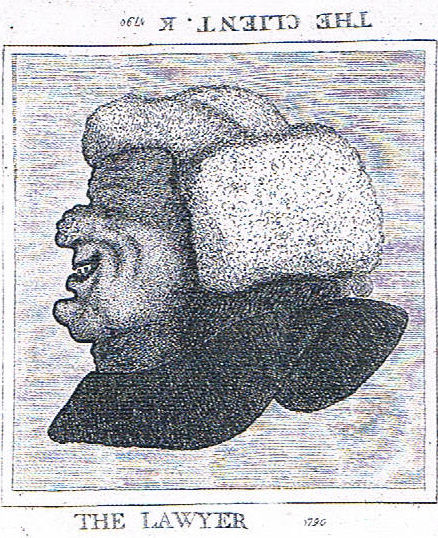
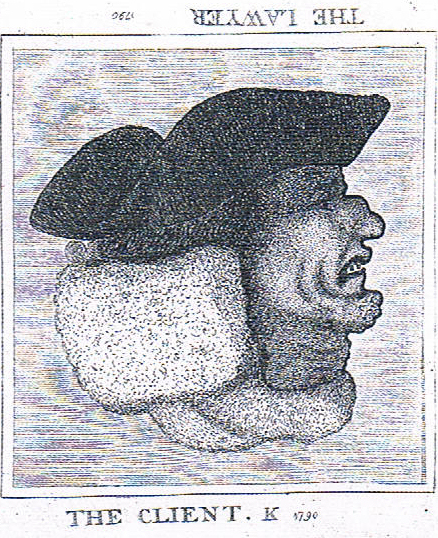
Lawyer and client, one of
Kay's best known Topsy-Turvy prints. Make a copy and turn upside down to
see the client's face. "The last item on the legal invoice presented to
the client was usually the tavern bill."
Upon his death in February 1826, the twice-married Kay was buried in the
northwest corner of Greyfriars Kirkyard by the Flodden Wall. I look forward
to visiting his grave on my next trip to Scotland early next year. His is
the grave of a man we all owe a debt to, who by the way, had no gravestone
for over 200 years. The name of John Kay will never die because his works
will live on for centuries. People like Sheila Szatkowski will see to that!
I want to personally thank Sheila for this remarkable book. It is good news
indeed to learn that “a definitive book on John Kay is on the drawing board”
as she continues to work diligently to bring attention to John Kay, the man
described by his widow as one who “cared for no employment except that of
etching likenesses! (FRS: 8.12.10) |
